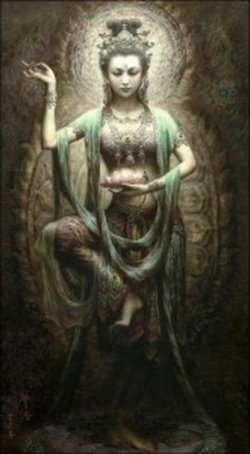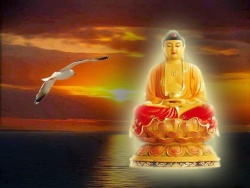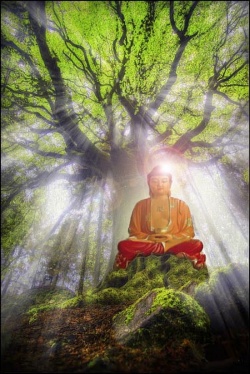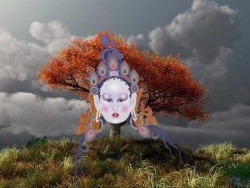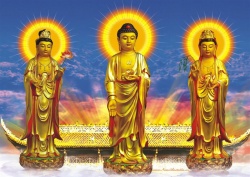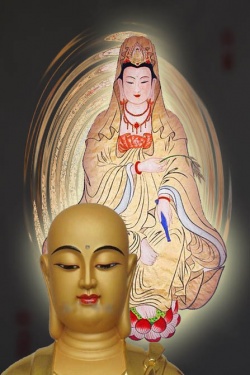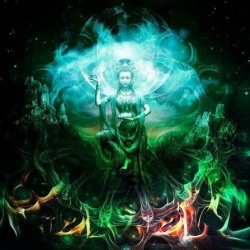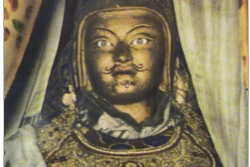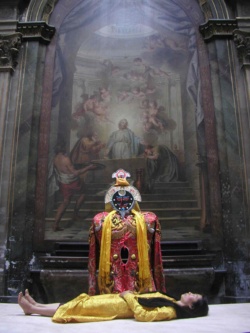Tantric Buddhism
Tantric Buddhism
タントラ仏教 ( Jpn Tantora-bukkyo)
Also, Vajrayana, Mantrayana, or Esoteric Buddhism.
A stream of Buddhist thought and practice that became formalized in India and flourished from the seventh to the eleventh century.
Tantric Esotericism became a part of the broader Mahayana movement and represents an infusion of popular magic, mysticism, and ritual into the Indian schools of Buddhism. The Sanskrit word tantra means loom or warp of cloth, essential part, or doctrine.
Tantra also refers to a class of Hindu or Buddhist scriptures on esoteric practices that developed rather late in the history of the literatures of those religions.
They emphasize benefits that accrue from the recitation of mantras (magical formulas), the formation of mudras (hand gestures), the performance of rituals, the use of mandalas (ritual diagrams), and other practices.
Tantric thought became a formalized stream within Mahayana Buddhism around the seventh century and spread to [[Wikipedia:Central Asia|Central Asia]], China, and Tibet.
Tantric tradition is an important element of Tibetan Buddhism.
Bu-ston, a Tibetan scholar of the fourteenth century, classified Indian Buddhist tantras into four general categories: Kriya-tantra, dealing with ritual acts; Charya-tantra, which combines ritual acts with meditation;
Yoga-tantra, dealing chiefly with meditation; and Anuttarayoga-tantra, or supreme yoga tantras.
The fourth form, Anuttarayoga-tantra, which was not introduced to China and Japan, is the strongest in sexual symbolism, identifying prajna,
or wisdom, as a female principle; upaya, or expedient means, as a male principle; and enlightenment as a union of these two.
Some of its practitioners interpreted this symbolism literally and sought enlightenment in the sexual union of man and woman.
The earliest esoteric Buddhist tantras, such as the Sanskrit texts of the Mahavairochana Sutra and the Diamond Crown Sutra, were produced in India in the seventh century.
In China, Esoteric Buddhism was introduced and established by the Indian monks Shanwuwei (Skt Shubhakarasimha, 637-735), Chin-kang-chih (Vajrabodhi, 671-741), Pu-k'ung (Amoghavajra, 705-774), and others.
Its teachings were systematized to enable the attainment of Buddhahood in one's present body.
The Sanskrit Buddhist tantras were translated into Chinese and spread as esoteric sutras and teachings featuring mudras, mantras, and mandalas.
In Japan, Kobo(774-835; also known as Kukai) formulated his own systematization of these teachings, founding the True Word (Shingon) school based upon them. Esoteric Buddhism was also accepted and developed by the Tendai school in Japan.
Vajrayana, or Tantric Buddhism, has been described as the latest phase in the development and evolution of Buddhist thought. For a long time, Western scholars dismissed Vajrayana as the final "degenerate phase" of Buddhist thought.
This attitude was due to the fact that these materialistic scholars had only a Christian or a secular way of seeing the world.
They could appreciate ordinary Buddhism (Theravada, etc), seeing the Buddha as the Christ of the East teaching an essentially moral message, or as a sort of spiritual humanist;
but when faced with a system of knowledge and practice that embraced all the magical and occult elements that Western rationalism had rejected centuries ago, could only explain it as some sort of degenerate end phase.
Fortunately, in more recent times other Westerners have studied Tantric Buddhism first hand, at the feet of actual Tibetan Masters, and so have a more mature appreciation and respect for that noble tradition.
Indeed, if anything good has come out of the terrible Chinese invasion and oppression of the Tibetan homeland in the 2nd half of the 20th century, it has been that this has driven Tibetan lamas and teachers to the West, and encouraged them to spread their tradition among sympathetic Westerners.
Vajrayana metaphysics is, like Indian Tantra, a hybrid affair: a coming together of Indian Tantrism, Mahayana Buddhism, and the original aboriginal shamanism - the Bon tradition - of Tibet itself.
Like the Nathas, Shaktas, and Shaivites, the Vajrayanists postulated a subtle or iconographic body, made up of chakras, nadis, and subtle winds (vayu).
And like their Indian counterparts they worked on manipulating the forces of this subtle body through yoga in order to attain spiritual enlightenment.
But Vajrayana tantra diverged very early from Indian tantra.
Instead of the later seven-chakra model, they retain an earlier four chakra schema of navel, heart, throat, and head centres.
Starting from this four-chakra foundation, the Vajrayanists - like the Indian tantics - built up a very elaborate system of correspondences.
There are a number of other important differences to Indian (Shakta) Tantra as well. In Indian tantra one starts form the base chakra and progresses up.
In Tibetan tantra one starts from the head, which is the "lowest" level of consciousness (body, waking consciousness, wrathful deities), and progresses down to the heart, which is the highest level of consciousness.
With Indian Tantra the kundalini is awakened through specific breathing practices and yoga-postures.
The prana or vital-force of the subtle body is thus manipulated through the breath and the physical body; through an extension of Hatha yoga which, the reader will recall, was associated from the beginning with Indian Tantra.
In contrast, Vajrayana practice involves manipulating the vital force through the mind and concentration.
Through intense visualisation of deities and so on, one activates the inner "winds" (= prana = ch'i) and "drops".
The Instead of the Kundalini-Shakti or "Serpent Fire" of Shakta Tantrism, Vajrayana has the Tumo (literally "fierce woman").
Through intense visualisation of deities and concentration upon the "lower tip" (the minor chakra at the tip of the sex-organ), the winds (prana) are drawn into the lower opening of the central channel (sushumna), producing an intense heat, called tumo Daniel Cozort, Highest Yoga Tantra, p.71].
In her fascinating book, Magic and Mystery in Tibet Alexandra David-Neel popularised stories of Tibetan yogis drying icy sheets with their naked bodies outside in the middle of winter. That is a showy exhibition of tumo.
Real tumo of course is the tantric meditation itself.
As a result of the tumo-heat, the drops melt and enter the central channel.
The red "female" drops in the navel chakra ascends to the heart chakra, while the white drops in the crown chakra descend to the same chakra.
The bliss of the drops flowing in the central channel is said to be a hundred times greater than that of orgasm .
The drops, moving up or down the central channel, finally enter the "indestructable drop" in the heart chakra, so called because it is said to be drop that passes from life-time to life-time, taking with it the "very subtle mind" and "very subtle wind" [p.72].
The entire visualisation or meditation stage itself is called the stage of Generation, as its purpose of is to construct or generate an actual enlightenment or buddha-body, the stage of Completion.
The result of all this is that one rises in an "illusory body", so called because it is a spirit body rather than a physical body, and at death, rather than be caught up by the bardo and reincarnation, one remains in full consciousness in the illusory body, so attaining Buddhahood.
